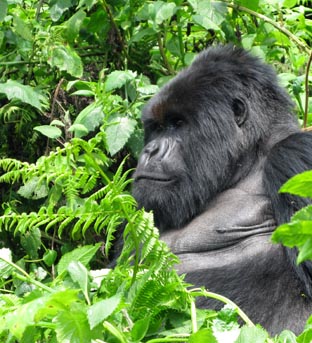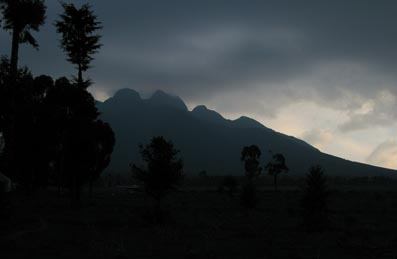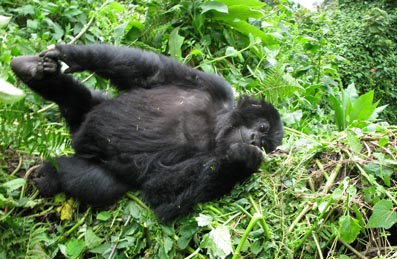This is a guest post by Rebecca Tom. If you want to guest post on Go Backpacking, please read more here.
Trekking to see the mountain gorillas of Rwanda is one of the most magical things you can do. It is an amazing wildlife encounter with Earth's largest living primates.
The German explorer Oscar von Beringe was the first non-African to encounter them in 1902. There are now estimated to be less than 750 in the world (all living in eastern central Africa).
Wars, poaching, and human encroachment on their habitat have all played a part in drastically reducing their numbers. They are critically endangered and so it is even more special to be able to see them up close in the wild.
I was lucky enough to do this and I will never forget it.
There are seven habituated gorilla groups in Rwanda that tourists are allowed to visit. There are other habituated groups too but these are off limits. A maximum of eight permits are issued per gorilla group per day.
Before encountering the animals there's a few things to bear in mind. There is a code of conduct for visiting the gorillas: the encounter will be no more than one hour from first sighting (to reduce the risk of them catching human diseases), the minimum distance you can get from them is 7m, no-one can eat near them or go to the loo near them, no flash photography and absolutely no litter should be left there. Also, permits are required which cost $500 and need to be bought in advance.
Those unfortunate enough to develop a cold or infectious disease before the encounter will not be allowed to see the gorillas.
My encounter started with arrival at the meeting point at 7am. Everyone gets put into small groups and a briefing takes place. The park wardens choose which people visit which gorilla family. We were off to meet the Umabano (meaning neighbourliness), a group of nine individuals led by one silverback, Charles.
Luckily I'd been told to bring gardening gloves and tough trousers as the forest is likely to spike and sting you. Good walking shoes are necessary as the terrain is tough and the paths are narrow. Waterproofs are a good idea too as it is a rainforest (although I didn't need them). A bottle of water is essential, as is a hearty breakfast to make up for all the energy that will be expended with the climb.
Ruhengeri is the nearest village to the start of the trail and is where the jeeps from the base take us, the roads are very bumpy and the guides joke that it is an “˜African massage'.
The guides cut walking sticks to help us with our climb and we enter the primary Rwandan Parc des Volcans rainforest.
Our guides are in frequent walkie-talkie contact with the trackers who are up ahead searching for the gorillas. The trackers search for dung and trampled vegetation that mark a gorilla trail. The guides make frequent stops for us to rest and they use their machetes to slash some of the undergrowth from the tangled jungle at the edge of the path.
After about an hour and a half of trekking, we were told to leave all food and our sticks behind for the final push to the gorilla group. The sticks needed to be left behind because the gorillas apparently may associate them with poachers and become alarmed.
A bit more walking for us and then they were there in front of us, fellow primates. They were difficult to spot at first but the movement in the trees gave the game away. An awesome sight, my first wild gorilla in the tree only a few metres away.
And then there were more – little ones swinging playfully on branches and juveniles crashing about in the undergrowth. The female seemed more intent on sleeping than anything else but a baby clambered about near her, ensuring she didn't manage a decent amount of sleep!
We were by now venturing off the paths and teetering precariously on the hillside. It was difficult to see where there was hard surface under foot so a few falls were inevitable.
We tried keeping our distance but a juvenile came along a path and there was nowhere for me to move to. It passed just inches away, as if I wasn't even there. An amazing experience!
Charles the silverback was a sight to behold. He was massive and majestic and no threat at all if you were respectful.
The animals carried out their daily life in front of us, eating, sleeping and playing.
The trackers constantly communicated with the gorillas in low grunts. The gorillas are used to the trackers as they are followed daily.
All too soon the hour was up and we had to go. We were escorted out by one of the juvenile male gorillas who apparently sometimes likes to do this.
Sadly it was time to head back, tired but exhilarated but every penny and every step was worth it.
________
By Rebecca Tom. If you liked this post you may also be interested, like me, in cultural walking tours or walking and wildlife in Namibia.
Photo Credit: All photos courtesy of Rebecca Tom.
This post was written by a guest contributor. Please reference the author's byline in the post above for more information. If you would like to guest post on Go Backpacking, please read our submission guidelines. For information on advertising opportunities, go here.
Planning a trip? Go Backpacking recommends:
- G Adventures for small group tours.
- Hostelworld for booking hostels.




Dave
Wednesday 30th of December 2009
Jessica -
One thing I learned on my RTW trip is that it's always cheaper to book these kinds of tours once you arrive in the country. I'm not sure how far in advance you need to arrange the permit, but when I saw the prices for these gorilla trekking trips in the adventure company catalogs I knew I'd not be in a position to afford it as a normal American vacation.
But sounds like you'll be in a great position to do it once you get traveling. I wish I'd made Africa a bigger priority on my trip. At least I have a reason (or hundreds) to go back!
Dave
Wednesday 30th of December 2009
Jessica -
One thing I learned on my RTW trip is that it's always cheaper to book these kinds of tours once you arrive in the country. I'm not sure how far in advance you need to arrange the permit, but when I saw the prices for these gorilla trekking trips in the adventure company catalogs I knew I'd not be in a position to afford it as a normal American vacation.
But sounds like you'll be in a great position to do it once you get traveling. I wish I'd made Africa a bigger priority on my trip. At least I have a reason (or hundreds) to go back!
Jessica
Wednesday 30th of December 2009
Incredible post! My husband and I are planning a trip to either Rwanda or Uganda to see the Gorillas around July 2010. It is wonderful to hear about how amazing the experience is, we can't wait. We feel so lucky to have the opportunity to see these amazing animals in the wild. Any suggestions on Rwanda versus Uganda, how far in advance to purchase the permit, best trekking company to use?
Thanks,JessicaThe VanNess Vagabonds
Dave
Monday 28th of December 2009
T-roy -
I met a birding fanatic (aka "birder") in Botswana and she had been to Uganda for the birding, and also went on a gorilla trek. It's something I'd love to do as well, but it's not cheap. As Rebecca mentioned, you have to buy the permit, but you're not guaranteed to see the gorillas.
I think it'd make sense as part of a bigger trip, but I personally couldn't plan a trip around just one experience like that. Then again, I did make it a point to visit South Africa to cage dive with great white sharks.
Nevermind! :)
foggodyssey
Monday 28th of December 2009
Awesome post Rebecca!! Makes me want to go their now and see them with my own eyes. I remember watching the movie "Gorillas in the Mist" and have always wanted to have an opportunity to do it one day. Thanks for stirring up that old memory and adding more motivation to it. :)